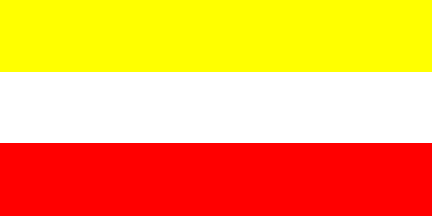 klaus-michael schneider
klaus-michael schneider
Keywords: boyaca | paz de rio |
Links: FOTW homepage | search | disclaimer and copyright | write us | mirrors

Last modified: 2021-08-26 by  klaus-michael schneider
klaus-michael schneider
Keywords: boyaca | paz de rio |
Links: FOTW homepage |
search |
disclaimer and copyright |
write us |
mirrors

image by Dov Gutterman, 21 September 2008
See also:
Paz de Río is a municipality (since 20 July 1935) in the
Colombian Department of Boyacá, part of the the subregion of the
Valderrama Province.
The flag of Paz de Río is horizontally divided yellow-white-red.
Source: municipal
web site
Dov Gutterman, 21 September 2008
Translated from municipal
web site:
"The colours are yellow, white and red, arranged in
horizontal stripes of equal dimensions, yellow meaning richness,
white symbolizing peace and red representing the ore deposits
located on the municipal territory."
The original village of La Paz was suppressed on 23 November 1933
by a big landslide. Rebuilt in a safer place, the village was
renamed La Paz de Río by Decree No. 6 of the Departmental
Assembly of Boyacá on 31 March 1936. The new name celebrates the
peace treaty signed between Colombia and Peru in Rio de Janeiro
on 24 May 1934.
As proposed by Dr. Marco Antonio Mejía Gómez, Representative of
the Province of Valderrama, the Departmental Assembly of Boyacá
approved on 28 June 1938 Decree No. 018 the exploitation of the
iron mines in the surroundings of the recently refounded village.
Following technical tests, the Colombian government created by
Law No. 45 in December 1947 the "Empresa Siderúrgica
Nacional de Paz de Río", superseded on 17 September 1948 by
the "Sociedad Anónima SemiOficial Empresa Siderúrgica
Nacional de Paz de Río". The inaguration on 11 May 1954 of
an airborne cable system allowed the transportation of iron ore
from the mine of La Chapa directly to the washing unit. Later on,
open cute mines were exploited in La Mesa, El Uvo and
Coloradales, using modern technilogy imported from Europe and
North America. A railway was built to Belencito, where steel was
manufactured. In 1954, the copany was renamed to its actual name,
"Acerías Paz del Río S.A.". On 13 October 1954, the
first 20 ingots, 900 kg each, were produced in the steelworks.
Ivan Sache, 2 October 2008
byvpr.jpg)
image from municipal
web site